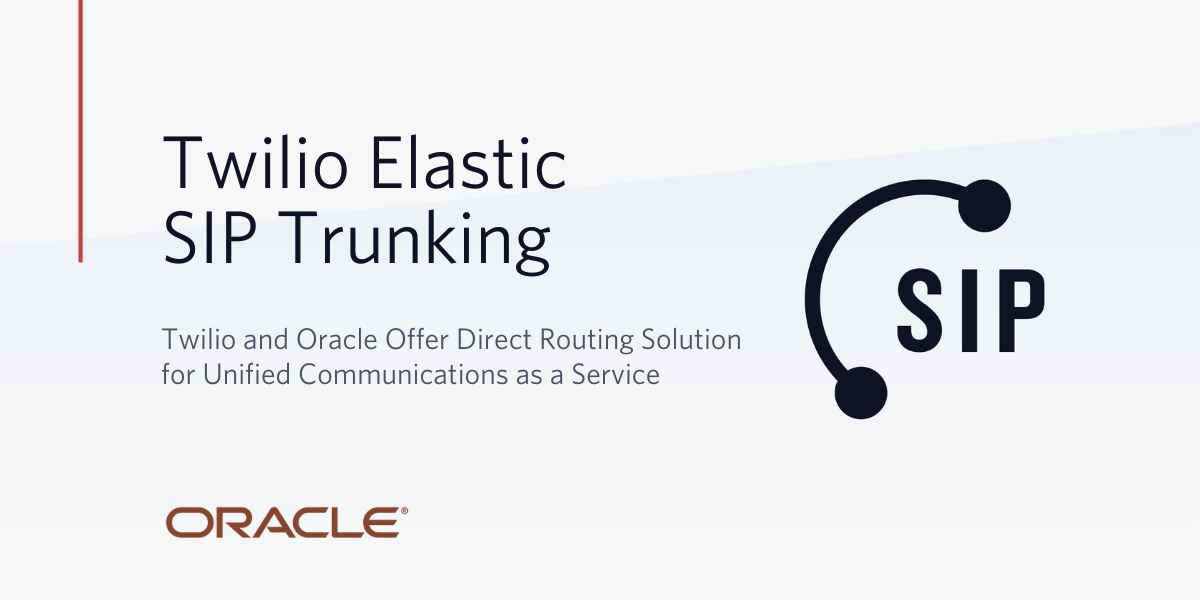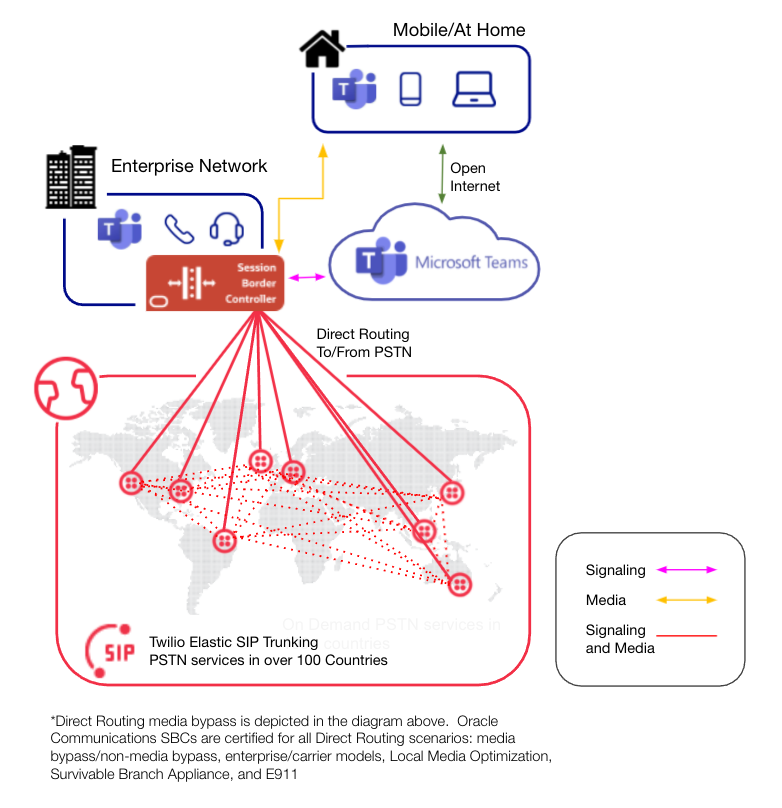Twilio and Oracle Offer Direct Routing Solution for Unified Communications as a Service
Time to read:

Unified communications platforms have become increasingly popular as organizations contemplate the future of a geographically diverse workforce and migration from traditional on-premises infrastructure to cloud. As a result, businesses are seeking robust, economical, and scalable solutions to improve global communications over voice, messaging, video, and conference.
To help meet this growing market demand, Twilio and Oracle have joined together to bring organizations a joint solution that leverages the Microsoft Teams Direct Routing function and combines Twilio Elastic SIP Trunking with Oracle Communications Session Border Controllers (SBCs). These solutions give users the ability to send and receive Public Switched Telephone Network (PSTN) phone calls in over 100 countries around the globe.

UCaaS and BYOC and Microsoft, Oh My!
In this age of “X” as a Service, communications vendors both far and wide have launched cloud-based offerings that enable voice, messaging, video, and conference. More commonly known in the industry as Unified Communications as a Service (UCaaS), these platforms have become increasingly popular.
The majority of UCaaS vendors seek to offer their customers a comprehensive feature set, enabling them to communicate with users inside the organization as well as those outside. In many cases, as it is with Microsoft Teams, this includes the ability to send and receive voice calls over the PSTN.
Bring Your Own Carrier (BYOC) represents the ability for users of a UCaaS platform to select any SIP Trunking provider and use that provider to receive and transmit their PSTN calls.
With Microsoft Teams, BYOC is accomplished by enabling a feature called Direct Routing. This feature enables users of Microsoft’s platform to seamlessly integrate with a Third-party telephony carrier for the purposes of making outbound and receiving inbound PSTN calls through the Teams dial pad interface.
Since it was introduced in 2017, the Direct Routing feature has become the preferred way for organizations to send and receive PSTN calls. Today, an estimated 80% of Teams subscribers opt for Direct Routing instead of Microsoft Calling Plans.
Microsoft Teams Direct Routing
Weighing the pros and cons of deploying a specific solution is commonplace in our industry. Our collective years working in the communications space have taught us that there typically isn’t a “one size fits all”, and at the end of the day we all strive to provide our organizations with services that fit and provide a measurable advantage. When comparing Direct Routing; which connects Teams users to a third-party SIP trunking service, against Microsoft Calling Plans; which bundles in PSTN connectivity, it’s important to consider the trade-offs that affect cost, flexibility, local number availability and complexity. It is best practice to carefully evaluate the options before selecting which solution is right for your organization and we’ve listed some key comparison points below:
Direct Routing (BYOC) advantages
- Global coverage - Depending upon the SIP trunking provider you choose, you may find DID and toll-free numbers are available in more places than the 15 countries supported by Microsoft Calling Plans. For example, Twilio Elastic SIP Trunking offers PSTN service in 100 countries.
- Low rates - PSTN usage rates may be lower depending on the carrier you select; we recommend you compare prices for inbound, outbound and toll-free services by country.
- Flexible migration - Your SBC may connect users on legacy telephony systems to those on Microsoft Teams. Direct Routing provides flexibility to migrate users at your own pace, instead of managing a flash cut, and enables users connected to specialized telephony systems (e.g. contact centers) to communicate with Teams users.
- Routing flexibility - You can leverage your SBC and/or SIP trunking service provider to apply routing policies before session hand-off to Microsoft Teams. This enables you to control the experience, including outbound source phone number and inbound routing.
- Simplified operations - Consolidate Microsoft Teams trunks with other trunk services (CCaaS, on-premises VoIP, embedded apps., etc.). Instead of fragmenting PSTN connectivity across multiple providers, you can simplify operations and administration by leveraging a single SIP trunking service provider for all your PSTN connectivity needs.
- Eliminates Cloud Connector Edition - Organizations migrating from Skype for Business will be pleased to know that a Microsoft certified SBC takes the place of Cloud Connector Edition (CCE). Microsoft CCE was the platform that previously enabled SIP trunking connectivity for SfB.
Going Global with Direct Routing and Twilio Elastic SIP Trunking
Solutions that leverage Microsoft Teams Direct routing connect Teams users to the PSTN via a SIP Carrier service, such as Twilio Elastic SIP Trunking. The Twilio/Oracle solution consists of an Oracle Communications SBC and a Twilio Elastic SIP Trunk. The SBC, which can be deployed as virtualized software or on-premises as a hardware appliance, forms a pivot point in the solution, routing calls between the Microsoft Teams cloud and the Twilio trunking service. Additionally, the Oracle SBC can be used to connect on-premises Contact Center and UC infrastructure from vendors like Cisco, Avaya, and Genesys to Twilio Elastic SIP Trunking. Using the Oracle SBC in this way enables enterprises to seamlessly deploy a hybrid cloud model which utilizes the same Twilio SIP Trunking service for PSTN connectivity across all components whether they are located on-premises or in the cloud.

Oracle SBCs enable BYOC and bridge the gap between On Premise and Cloud
Oracle first partnered with Microsoft with the certification of the Oracle SBC for Microsoft Lync, and continued throughout the last 11 years resulting in the certification of the Oracle SBC for Microsoft Skype for Business, and Microsoft Teams Direct Routing scenarios.
The Oracle SBC provides BYOC with strong security, high availability, and interoperability for enterprise VoIP and Unified Communications (UC) networks. Available in either hardware-based, VNF or Cloud, Oracle Session Border Controllers help connect disparate SIP-based real-time communications networks while mitigating security threats and ensuring reliable communications, for Cloud-only or hybrid deployments. Here are a few reasons to select the Oracle SBC for your Microsoft Teams Direct Routing deployment:
- Certified: Oracle SBC is fully certified for Direct Routing for all available scenarios: media bypass/non-media bypass, enterprise/carrier models, Local Media Optimization, Survivable Branch Appliance, and E911
- Security architecture: Provides advanced DoS/DDoS protection, media policing and intrusion detection. Leading industry security certifications.
- Best of breed: 20+ years of heritage protecting enterprise networks with expertise of cloud and business critical communications
- Interoperability is in our DNA - a history of enabling and empowering multi-vendor, hybrid communications environments
- Cloud innovation to deliver intelligent monitoring solutions leveraging analytics/ML for anomaly detection and threat mitigation
- High scalability: Scales up to 160,000 media sessions (60,000 transcoded) in a single entity (Acme Packet 6350 datasheet)
- Most proven SBC on Global 2000 accounts: Wide range of supported SIP use cases securing +1600 enterprise networks across the world.
- Tools for industrialization and automation: Single management pane of glass view via OSDMC, REST API provisioning
- End-to-end quality of service monitoring: Media QoS measurement and reporting directly in the SBC, end to end monitoring via OCOM – including encrypted side traffic
- Best-practice guidance for deployment: Documented configuration recommendations available based on decades of expertise in the most demanding telecom operating networks across the world
Twilio Elastic SIP Trunking scales the solution worldwide
Twilio Elastic SIP Trunking (ESIPT) services complement the Oracle Communications SBC by applying agility, global scale, cost savings, and forward-looking innovation to consumers of Microsoft Teams.
ESIPT helps organizations streamline procurement, deployment, and operational workflows associated with connecting to the PSTN by delivering an on demand SIP trunking service that can be turned up in minutes, scales capacity based on need, bills only for capacity used, and is available in over 100 countries worldwide.
Twilio Elastic SIP Trunking differentiates itself from other SIP/PSTN carriers through:
- On Demand provisioning allows Twilio customers to procure and provision phone numbers and trunking services in minutes through the central Twilio Console portal or API.
- Global connectivity provides Twilio customers with services in 100 countries, including clean, toll-free and DID phone numbers.
- Cost effective Toll-free and DID prices combine with a usage-based pricing model to reduce telecom spend.
- Automatic scale removes the need to forecast, plan, and pre-procure capacity for traffic peaks and seasonal spikes. The Twilio ESIPT network is designed to scale up and down based on need.
- Resilience is an inherent part of the Twilio ESIPT solution which helps customers embed highly resilient, geographically dispersed-fault tolerance into their solution architectures.
- Simplified operations is realized by customers who leverage Twilio SIP trunks to consolidate PSTN connectivity across all their communications services, including VoIP, UC, collaboration and communications-enabled applications
- Advanced features offer a range of applications from call recording, to phone number manipulation* and the ability to debug through Twilio Insights through the Twilio Console portal.
Deploying Microsoft Teams for the Future
Unified Communications will be deployed by both domestic and global organizations for the foreseeable future. The Microsoft Teams Direct Routing feature offers the BYOC advantage of leveraging world class SIP trunking services to connect users to the PSTN.
When deploying Teams with Direct Routing, enterprises gain flexibility to source PSTN connectivity from their preferred SIP trunking service provider. This enables them to leverage differentiating factors like geographic coverage, innovative features, and low usage rates to give their organization a competitive edge.
The Twilio and Oracle solution for Microsoft Teams provides IT managers a highly reliable solution for PSTN connectivity in over 100 countries. It features low calling rates, on-demand provisioning and interoperability with legacy telephony systems which helps streamline user migration. The solution is verified by Oracle and Twilio which enables organizations to deploy it with confidence.
Ready to get started? Read more about Twilio Elastic SIP Trunking Solution Blueprints.
Robert McCulley is a member of the Twilio Voice and Video product team. In this role he focuses on building solutions that provide organizations a competitive edge through cloud platform technology.
Related Posts
Related Resources
Twilio Docs
From APIs to SDKs to sample apps
API reference documentation, SDKs, helper libraries, quickstarts, and tutorials for your language and platform.
Resource Center
The latest ebooks, industry reports, and webinars
Learn from customer engagement experts to improve your own communication.
Ahoy
Twilio's developer community hub
Best practices, code samples, and inspiration to build communications and digital engagement experiences.

